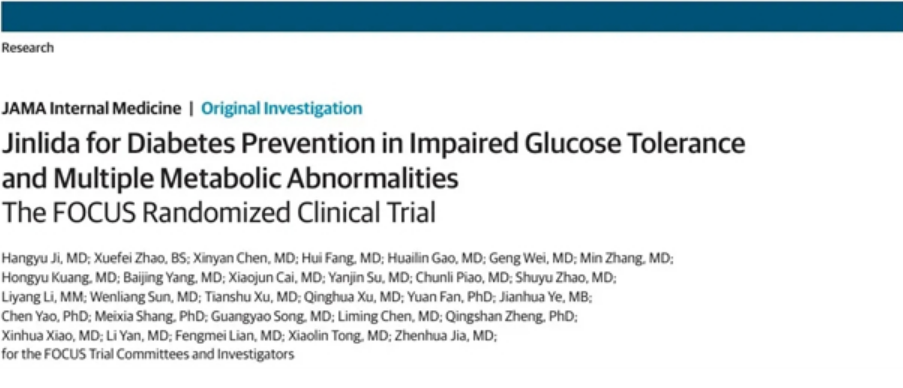The FOCUS Randomized Clinical Trial

Key Points
Question Can long-term use of Jinlida granules (JLD) reduce the incidence of diabetes in participants with impaired glucose tolerance (IGT) and multiple metabolic abnormalities?
Findings In this randomized clinical trial of 889 participants with IGT and multiple metabolic abnormalities, after a median follow-up of 2.20 years, the JLD group had a significantly lower risk of developing diabetes compared with the placebo group.
Meaning In participants with IGT combined with multiple metabolic disorders, JLD reduced the incidence of diabetes compared with placebo.
Abstract
Importance Previous studies have shown that Jinlida (JLD) granules, an approved treatment for type 2 diabetes in China, can reduce blood glucose level, reduce glycated hemoglobin (HbA1c), and improve insulin resistance in people with type 2 diabetes.
Objective To evaluate the effect of long-term administration of JLD vs placebo on the incidence of diabetes in participants with impaired glucose tolerance (IGT) and multiple metabolic abnormalities.
Design, Setting, and Participants This multicenter, double-blind, placebo-controlled randomized clinical trial (FOCUS) was conducted across 35 centers in 21 cities in China from June 2019 to February 2023. Individuals aged 18 to 70 years with IGT and multiple metabolic abnormalities were enrolled.
Intervention Participants were randomly allocated 1:1 to receive JLD or placebo (9 g, 3 times per day, orally). They continued this regimen until they developed diabetes, withdrew from the study, were lost to follow-up, or died.
Main Outcomes and Measures The primary outcome was the occurrence of diabetes, which was determined by 2 consecutive oral glucose tolerance tests. Secondary outcomes included waist circumference; fasting and 2-hour postprandial plasma glucose levels; HbA1c; fasting insulin level; homeostatic model assessment for insulin resistance (HOMA-IR); total cholesterol, low-density lipoprotein cholesterol, and triglyceride levels; ankle-brachial index; and carotid intima-media thickness.
Results A total of 889 participants were randomized, of whom 885 were in the full analysis set (442 in the JLD group; 443 in the placebo group; mean [SD] age, 52.57 [10.33] years; 463 [52.32%] female). Following a median observation period of 2.20 years (IQR, 1.27-2.64 years), participants in the JLD group had a lower risk of developing diabetes compared with those in the placebo group (hazard ratio, 0.59; 95% CI, 0.46-0.74; P < .001). During the follow-up period, the JLD group had a between-group difference of 0.95 cm (95% CI, 0.36-1.55 cm) in waist circumference, 9.2 mg/dL (95% CI, 5.4-13.0 mg/dL) in 2-hour postprandial blood glucose level, 3.8 mg/dL (95% CI, 2.2-5.6 mg/dL) in fasting blood glucose level, 0.20% (95% CI, 0.13%-0.27%) in HbA1c, 6.6 mg/dL (95% CI, 1.9-11.2) in total cholesterol level, 4.3 mg/dL (95% CI, 0.8-7.7 mg/dL) in low-density lipoprotein cholesterol level, 25.7 mg/dL (95% CI, 15.9-35.4 mg/dL) in triglyceride levels, and 0.47 (95% CI, 0.12-0.83) in HOMA-IR compared with the placebo group. After 24 months of follow-up, the JLD group had a significant improvement in ankle-brachial index and waist circumference compared with the placebo group.
Conclusions and Relevance The findings suggest that JLD can reduce the risk of diabetes in participants with IGT and multiple metabolic abnormalities.
Trial Registration Chinese Clinical Trial Register: ChiCTR1900023241
